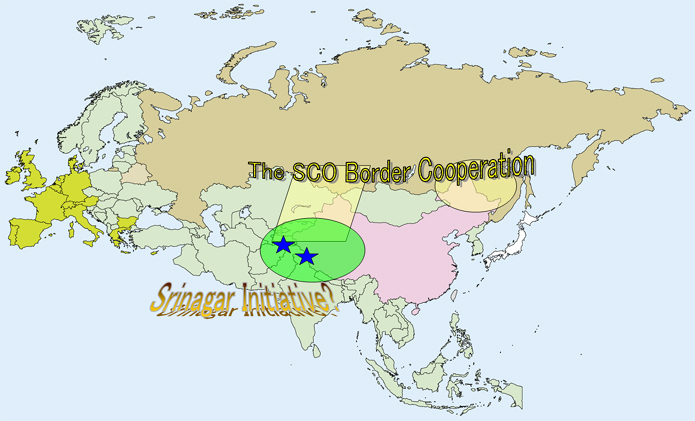|
Enhancing Regional Peace and Stability: An Initiative from Srinagar,
Kashmir
By
Akihiro Iwashita

One of the
critical regions for border disputes is in Central Eurasia; the Jammu
and Kashmir area stretching from the India-Pakistan “Line of Control”
toward the Indo-China “unsettled” border region of Aksai Chin. This
area could be a test for new and emerging border dynamics, which the
Russia-China border settlement and regional cooperation had initiated
and developed since the late 1990s onward on Eurasia. Under the
Shanghai Cooperation Organization framework (“Shanghai Five” up to
2001), China’s long border in the Xinjiang Uyghur Autonomous Region
with Russia, Kazakhstan, Kyrgyzstan and Tajikistan was settled,
stabilized and developed. Considering the military conflicts and
tension of the 1960s over the border, the recent achievements
throughout the region have been amazing and unexpected. Thanks to this
success, most of the local residents in the region, regardless of their
nationalities and religions, are currently enjoying a revival of trade,
transportation and interactions over the border. Here is seen one of
the apparent phenomena --- a contemporary revival of the ancient “Silk
Road.”
From October 15-18, 2008, the “Dynamics & Revival of Silk Route:
Perspective, Challenges & Opportunities” conference was held at the
Centre of Central Asian Studies, University of Kashmir, India.
Distinguished experts from Kazakhstan, Uzbekistan, Kyrgyzstan,
Tajikistan and even Turkmenistan (a representative from the Indian
Embassy) participated. Specialists from Urumchi, China, and Kabul,
Afghanistan, as well as from the US, Italy and Japan also were in
attendance. Well-known Indian scholars were also there: Mansura Haidar,
Professor at the Centre of Advanced Study in History, Aligarh Muslim
University, P. L. Dash, Professor at the Centre of Central Eurasian
Studies, University of Mumbai, and Riyaz Punjabi, Vice Chancellor,
University of Kashmir.
This conference was one of the most productive conferences that I have
ever attended. It was well-organized, well-balanced and included timely
opportunities for intensive and fruitful discussions over Central Asia
and its surrounding regions under the supervision of Mushtaq A. Kaw and
G. M. Mir. The wide range of topics discussed and debated culture and
art, history, transportation perspectives, and international affairs
around/in Central Asia. Particularly, all of the participants who
visited Kashmir for the first time seemed to be strongly impressed by
the local challenges Kashmir people had struggled with and by the
possibility of Kashmir being reengaged in the North-South “Silk Road”
in the near future (through Pamir and Karakoram).
A foreign participant who had attended a conference on the similar
topic two years ago told me that a seemingly constructive change around
Srinagar was apparent though tight military control at the airport and
the main road remained. More than a few of the local residents hope
that normalization of regional life steadily progresses, and that
Srinagar realizes a revival of the rich and stable prosperity of the
past.
International support of this key area must be a necessary condition
toward achieving stability and prosperity. To boost regional, economic
and cultural cooperation in Central Eurasia, including Jammu and
Kashmir where it is geographically transparent at its crossroads but
has yet to realize its full potential, the international committee
issued a recommendation. In addition to the published text, the
committee also agreed on a non-academic agenda: To create a direct
route between Kashmir and the Karakoram pass (through the “Line of
Control”) and maintain the status quo of the border region. Opening the
currently closed border region toward a neighbor and the wider world
could bring benefit for local resident, regional neighbors and finally,
the country as a whole in the long run.
Over the past twenty years, there have been plenty of rich experiences
and lessons for the border arrangement that should prove useful to the
Shanghai Organization Cooperation framework. Why shouldn’t India and
Pakistan, as observer countries of the SCO, learn from these
experiences? Why shouldn’t China move forward, thus breaking from the
legacies of the past, as she did with Russia and Central Asia? I
believe a new agenda set by the Srinagar Initiative on Central Eurasia
could prove to be a major breakthrough in overcoming the long-standing
challenges of troubled border areas in the region. Only then will the
Srinagar conference’s initiatives be recognized as a small but first
step toward turning a new page on the regional revival.
See: Recommendation
Akihiro Iwashita, Director and Professor of the Slavic Research Center,
Hokkaido University, Japan, was Visiting Fellow of the Center for
Northeast Asian Policy Studies at the Brookings Institution, US
(2007-2008).
*The views expressed in the essay belong
solely to the author and do not represent the official position of any
organizations to which the author is permanently or was temporarily
affiliated.
[index]
|

